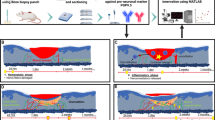Summary
The reinnervation of neurofilament-positive sensory nerve fibers in human skin after burn injury was investigated using an indirect immunohistochemical technique. In superficial burns, which healed spontaneously, a dense innervation pattern of neurofilament positive fibers were seen after 3–5 weeks. After 1–2 years the innervation pattern resembled that of normal nonburned skin. In deep burns, subjected to early or late excision and skingrafting, neurofilament positive fibers were seen in the dermis after 3–5 weeks and after 1–2 years a less dense innervation was observed, compared to non-burned skin. In these patients fibers were often seen running in parallel to the dermis-epidermis boundary with only a few fibers entering the epidermal layer. In deep burns that healed with hypertrophic scars only sparse neurofilament positive fibers were encountered 1–2 years after the injury.
Similar content being viewed by others
References
Aldskogius H, Hermanson A, Jonsson C-E. Reinnervation of an experimental superficial wounds in rats. Plast Reconstr Surg (in press)
Bjbrklund H, Dalsgaard C-J, Jonsson C-E, Hermanson A (1986) Sensory and autonomic innervation of non-hairy human skin. An immunohistochemical study. Cell Tissue Res 243:51–57
Coons AH (1958) Fluorescent antibody methods. In: JF Danielli (ed) General cytochemical methods. Academic Press, NY, pp 399–422
Dahl D, Bignami A (1977) Preparation of antisera to neuroflament protein from chicken brain and human sciatic nerve. J Comp Neurol 176:635–658
Dalsgaard C-J, Björklund H, Jonsson C-E, Hermanson A, Dahl D (1984) Distribution of neurofilament-immunreactive nerve fibers in human digital skin. Histochemistry 81:111–114
Dalsgaard C-J, Jonsson C-E, Hökfelt T, Cuello AC (1983) Localization of substance P-immunoreactive nerve fibers in human digital skin. Experientia 39:1018–1020
Folkerts JF, Sneep AJ, Meijling HA (1959) Comparative investigation on the return of sensation to skin graft. Biemont et al. (ed) Recent neurological research. Elsevier, Amsterdam London, pp 54–69
Fruhstorfer H, Lindblom U, Schmidt WG (1976) Method for quantitative estimation of thermal thresholds in patients. J Neurol Neurosurg Psychiatr 39:1071–1075
Hermanson A, Dalsgaard C-J (1986) Sensory reinnervation and sensibility in skin transplants. Med Biol (in press)
Hermanson A, Dalsgaard C-J, Arnander C, Lindblom U (1986) Sensibility and cutaneous reinnervation in free flaps. Plast Reconstr Surg (in press)
Hermanson A, Dalsgaard C-J, Björklund H, Lindblom U (1986) Sensory reinnervation and sensibility after superficial skin wounds. Neurosci Lett (in press)
Hermanson A, Jonsson C-E, Lindblom U (1986) Sensibility after burn injury. Clin Physiol 6:507
Kishimoto S (1984) The regeneration of substance P-containing nerve fibers in the process of burn wound healing in the guinea pig skin. J Invest Dermatol, 83:219–223
Lawson SN, Harper AA, Harper EI, Garson JA, Anderton BH (1984) A monoclonal antibody against neurofilament protein specifically labels a subpopulation of rat sensory neurons. J Comp Neurol 228:263–272
Lebowitz P, Singer M (1970) Neurotrophic control of protein synthesis in the regenerating limb of the newt, Triturius. Nature 225:824–827
Lembeck F, Holzer P (1979) Substance P as neurogenic mediator of antidromic vasodilation and neurogenic plasma extravasation Naunyn-Schmiedebergs Arch Pharmacol 310:175–183
Nilsson J, von Euler A, Dalsgaard C-J (1985) Stimulation of connective tissue cell growth by substance P and substance K. Nature, 315:61–63
Nilsson J, Sejerssen T, Hultgårdh-Nilsson A, Dalsgaard C-J (1986) Substance K-induced DNA synthesis correlates to the presence of myc-gene transcripts. Biochem Biophys Res Commun 137:167–174
Seiger Å, Dahl D, Ayer-Le Lievre C, Björklund H (1984) Appearance and distribution of neurofilament immunoreactivity in iris nerves. J Comp Neurol 223:457–470
Waris T, Rechardt L, Kyosola K (1983) Reinnervation of human skin grafts: A histochemical study. Plast Reconstr Surg 72:439–445
Author information
Authors and Affiliations
Rights and permissions
About this article
Cite this article
Hermanson, A., Dalsgaard, C.J., Jonsson, C.E. et al. A study of the cutaneous sensory reinnervation after burn injury using antibodies to neurofilament. Eur J Plast Surg 10, 115–118 (1987). https://doi.org/10.1007/BF00294474
Issue Date:
DOI: https://doi.org/10.1007/BF00294474




